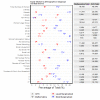Evaluation of a large-scale reproductive, maternal, newborn and child health and nutrition program in Bihar, India, through an equity lens
- PMID: 33425335
- PMCID: PMC7759017
- DOI: 10.7189/jogh.10.021011
Evaluation of a large-scale reproductive, maternal, newborn and child health and nutrition program in Bihar, India, through an equity lens
Abstract
Background: Despite increasing focus on health inequities in low- and middle income countries, significant disparities persist. We analysed impacts of a statewide maternal and child health program among the most compared to the least marginalised women in Bihar, India.
Methods: Utilising survey-weighted logistic regression, we estimated programmatic impact using difference-in-difference estimators from Mathematica data collected at the beginning (2012, n = 10 174) and after two years of program implementation (2014, n = 9611). We also examined changes in disparities over time using eight rounds of Community-based Household Surveys (CHS) (2012-2017, n = 48 349) collected by CARE India.
Results: At baseline for the Mathematica data, least marginalised women generally performed desired health-related behaviours more frequently than the most marginalised. After two years, most disparities persisted. Disparities increased for skilled birth attendant identification [+16.2% (most marginalised) vs +32.6% (least marginalized), P < 0.01) and skin-to-skin care (+14.8% vs +20.4%, P < 0.05), and decreased for immediate breastfeeding (+10.4 vs -4.9, P < 0.01). For the CHS data, odds ratios compared the most to the least marginalised women as referent. Results demonstrated that disparities were most significant for indicators reliant on access to care such as delivery in a facility (OR range: 0.15 to 0.48) or by a qualified doctor (OR range: 0.08 to 0.25), and seeking care for complications (OR range: 0.26 to 0.64).
Conclusions: Disparities observed at baseline generally persisted throughout program implementation. The most significant disparities were observed amongst behaviours dependent upon access to care. Changes in disparities largely were due to improvements for the least marginalised women without improvements for the most marginalised. Equity-based assessments of programmatic impacts, including those of universal health approaches, must be undertaken to monitor disparities and to ensure equitable and sustainable benefits for all.
Study registration: ClinicalTrials.gov number NCT02726230.
Copyright © 2020 by the Journal of Global Health. All rights reserved.
Conflict of interest statement
Competing interests: The authors have completed the ICMJE Unified Competing Interest form (available on request from the corresponding author) and declare no other competing interests.
Figures



References
-
- WHO. From Millennium Development goals to Sustainable Development Goals: the situation and trends in 2015. Geneva: World Health Organization; 2015.
-
- United Nations. Transforming our world: the 2030 Agenda for Sustainable Development New York, NY: United Nations; 2015.
-
- Asnake M, Bishaw T. The Addis Ababa Declaration on Global Health Equity: A call to action. Ethiopian Journal of Health Development. 2012;233-37 p.
